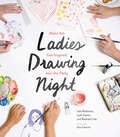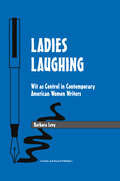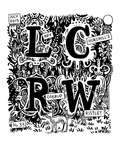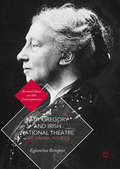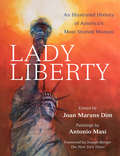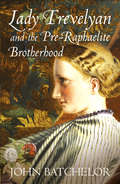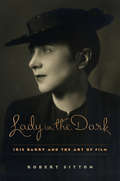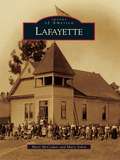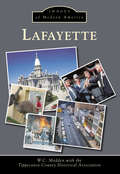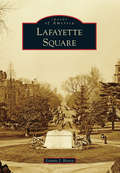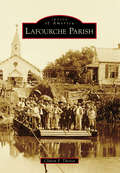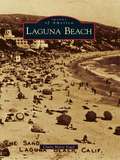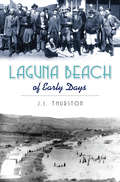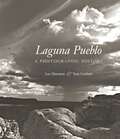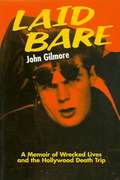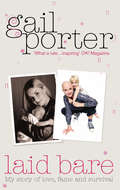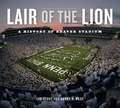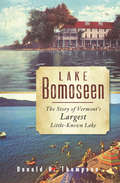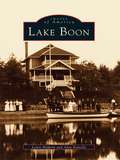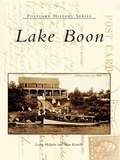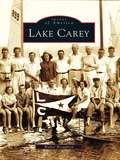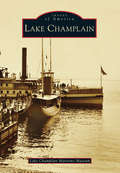- Table View
- List View
Ladies Drawing Night: Make Art, Get Inspired, Join the Party
by Julia Rothman Leah Goren Rachael ColeSpeaking directly to today's explosion of creativity, Ladies Drawing Night is for women looking to deepen their creative connections and expressions. Join rock star illustrators Julia Rothman, Leah Goren, and Rachael Cole for ten evenings of fun and art-making. Each night is led by a talented guest artist and themed around a particular topic, from large-scale ink painting to making art with kids. Samantha Hahn, Mary Kate McDevitt, Joana Avillez, and many more share their expertise. Each chapter includes loads of exciting artwork, insights about drawing, and instructions for that night's project. A rare peek into the minds and sketchbooks of some of the best female illustrators working today, this inspiring ebook is an irresistible invitation to host your own Ladies Drawing Night!
Ladies Laughing: Wit as Control in Contemporary American Women Writers (Studies In Humor And Gender Ser. #Vol. 3)
by Barbara LevyThis engaging and accessible book examines the world of seven contemporary, popular American women writers and their individual use of wit as a subtle and effective strategy to engage, or "control", the reader. A chapter is devoted to each of the seven writers - Lisa Alther, Rita Mae Brown, Nora Ephron, Shirley Jackson, Alison Lurier, Grace Paley, and Anne Tyler - and discusses their writings and their use of wit in the context of their lives. An opening chapter frames wit and control in psychological realities, and a concluding chapter summarizes the power of wit. A bibliography of the writers' works is also included, making this an ideal introduction and companion to these writers and their works.
Ladies Who Drink: A Stylishly Spirited Guide to Mixed Drinks and Small Bites
by Anne Keenan Higgins Marisa BulzoneA perfect housewarming gift or entertaining guide for any gathering of your gal pals, this is a gloriously glamorous excursion into the world of cocktails. Ladies Who Drink is a one-of-a-kind cocktail book that brings together classic and modern drink recipes, small-bite pairings, entertaining ideas, and to-die-for original fashions presented in a gorgeous array of scenes by illustrator Anne Keenan Higgins. Broken down by occasions like game day, book club, barbeque, or Sunday brunch, as well as moods like April in Paris, seaside sunset, or Mardi Gras, Ladies Who Drink is a dazzling entertaining guide filled with ideas for all your fun-filled occasions.
Ladies Who Punch: The Explosive Inside Story of "The View"
by Ramin SetoodehTHE INSTANT NEW YORK TIMES AND WALL STREET JOURNAL BESTSELLER <P><P>Like Fire & Fury, the gossipy real-life soap opera behind a serious show. When Barbara Walters launched The View, network executives told her that hosting it would tarnish her reputation. Instead, within ten years, she’d revolutionized morning TV and made household names of her co-hosts: Joy Behar, Star Jones, Meredith Vieira and Elisabeth Hasselbeck. But the daily chatfest didn’t just comment on the news. It became the news. And the headlines barely scratched the surface. <P><P>Based on unprecedented access, including stunning interviews with nearly every host, award-winning journalist Ramin Setoodeh takes you backstage where the stars really spoke their minds. Here's the full story of how Star, then Rosie, then Whoopi tried to take over the show, while Barbara struggled to maintain control of it all, a modern-day Lear with her media-savvy daughters. <P><P>You'll read about how so many co-hosts had a tough time fitting in, suffered humiliations at the table, then pushed themselves away, feeling betrayed—one nearly quitting during a commercial. Meanwhile, the director was being driven insane, especially by Rosie. <P><P>Setoodeh uncovers the truth about Star’s weight loss and wedding madness. Rosie’s feud with Trump. Whoopi’s toxic relationship with Rosie. Barbara’s difficulty stepping away. Plus, all the unseen hugs, snubs, tears—and one dead rodent. <P><P>Ladies Who Punch shows why The View can be mimicked and mocked, but it can never be matched. <P><b>A New York Times Bestseller</b>
Lady Churchill's Rosebud Wristlet No. 33
by Kelly Link Gavin J Grant Michael J. DelucaGuest edited by Michigan writer Michael J. DeLuca, LCRW #33 approaches its theme of humanity's relationship with the earth with a little humor, a touch of horror, and seventeen different kinds of understanding.<P><P> Includes multiple award winner Sofia Samatar, Nebula and Shirley Jackson award nominee Carmen Maria Machado, and World Fantasy Award nominee Christopher Brown among others.
Lady Gregory and Irish National Theatre: Art, Drama, Politics (Bernard Shaw And His Contemporaries Ser.)
by Eglantina RemportThis book is the first comprehensive critical assessment of the aesthetic and social ideals of Lady Augusta Gregory, founder, patron, director, and dramatist of the Abbey Theatre in Dublin. It elaborates on her distinctive vision of the social role of a National Theatre in Ireland, especially in relation to the various reform movements of her age: the Pre-Raphaelite Movement, the Co-operative Movement, and the Home Industries Movement. It illustrates the impact of John Ruskin on the aesthetic and social ideals of Lady Gregory and her circle that included Horace Plunkett, George Russell, John Millington Synge, William Butler Yeats, and George Bernard Shaw. All of these friends visited the celebrated Gregory residence of Coole Park in Country Galway, most famously Yeats. The study thus provides a pioneering evaluation of Ruskin’s immense influence on artistic, social, and political discourse in Ireland in the late nineteenth and early twentieth century.
Lady Liberty: An Illustrated History of America's Most Storied Woman (New York Masterpieces, Revealed)
by Antonio Masi Joan Marans DimMagnificent art complements an unvarnished history of the Statue of Liberty and its relationship to immigration policy in the United States throughout the years.What began in 1865 in Glatigny, France, at a dinner party hosted by esteemed university professor Édouard René de Laboulaye and attended by, among others, a promising young sculptor, Frédéric Auguste Bartholdi, was the extravagant notion of creating and giving a monumental statue to America that celebrated the young nation’s ideals. Bartholdi, and later civil engineer Alexandre-Gustave Eiffel, caught the spirit of the project and thus began the epic struggle to create, build, transport, and pay for the monument. Although The Statue of Liberty was to be a gift from France, the cost of its creation was meant to be shared with America. To the Lady’s creators and supporters, America offered liberty and the right to live one’s life unencumbered—that is, without fear and with a rule of law and a government that derived its power from the consent of the people it governed. Yet, in America, fundraising for the Lady dragged. Had it not been for publisher Joseph Pulitzer’s flashy fundraising campaign in his newspaper the World, the entire project likely would have collapsed.The tale, abundant with lively and interesting stories about the Statue of Liberty’s creators, is also told in the context of America’s immigration policies—past and present. Explored, too, is the American immigrant experience and how it viscerally connects to the Lady. Also integral to the tale is poetry—a sonnet—written by a then–largely unknown Jewish poet, Emma Lazarus, who moved a nation and gave a deeply rich and fresh meaning and purpose to the statue.In addition to the prose, Lady Liberty includes thirty-three elegant, full-page stirring paintings by celebrated artist Antonio Masi. Lady Liberty, a smart, timely, entertaining, and nonpartisan jewel of a book, is written for every American—young and old.Lady Liberty also speaks to the millions who dream of one day becoming Americans.Dim and Masi offer this book now because the Statue of Liberty, as a symbol of American beneficence, has never been more relevant . . . or more in jeopardy.
Lady Trevelyan and the Pre-Raphaelite Brotherhood
by John BatchelorAn entertaining account of an extraordinary cultural and historical event: - the establishment by one highly intelligent woman of a salon of the arts in a beautiful country house in Northumberland. Wallington Hall was remote from the major centres of artistic activity, such as London and Edinburgh. Yet Pauline Trevelyan single handedly made it the focus of High Victorian cultural life. Among those she attracted into her orbit were Ruskin, Swinburne, the Brownings, the Rossettis (Dante Gabriel, Christina and William Michael), Carlyle, and Millais and other members of the Pre-Raphaelite Brotherhood.The penniless but clever daughter of a clergyman, Pauline Jermyn married an older man whom she met through a shared passion for geology. Sir Walter Trevelyan was a philanthropist, teetotal, vegetarian, pacificist ... and very rich. With his encouragement, she collected works of art and decorated Wallington Hall with a cycle of vast paintings on the history of Northumberland. She was a patron of the arts who provided a fostering environment for many of the geniuses of her day. After her death, Swinburne wept every time her name was mentioned.
Lady in the Dark: Iris Barry and the Art of Film
by Robert SittonIris Barry (1895–1969) was a pivotal modern figure and one of the first intellectuals to treat film as an art form, appreciating its far-reaching, transformative power. Although she had the bearing of an aristocrat, she was the self-educated daughter of a brass founder and a palm-reader from the Isle of Man. An aspiring poet, Barry attracted the attention of Ezra Pound and joined a demimonde of Bloomsbury figures, including Ford Maddox Ford, T. S. Eliot, Arthur Waley, Edith Sitwell, and William Butler Yeats. She fell in love with Pound's eccentric fellow Vorticist, Wyndham Lewis, and had two children by him.In London, Barry pursued a career as a novelist, biographer, and critic of motion pictures. In America, she joined the modernist Askew Salon, where she met Alfred Barr, director of the new Museum of Modern Art. There she founded the museum's film department and became its first curator, assuring film's critical legitimacy. She convinced powerful Hollywood figures to submit their work for exhibition, creating a new respect for film and prompting the founding of the International Federation of Film Archives. Barry continued to augment MoMA's film library until World War II, when she joined the Office of Strategic Services to develop pro-American films with Orson Welles, Walt Disney, John Huston, and Frank Capra. Yet despite her patriotic efforts, Barry's "foreignness" and association with such filmmakers as Luis Buñuel made her the target of an anticommunist witch hunt. She eventually left for France and died in obscurity. Drawing on letters, memorabilia, and other documentary sources, Robert Sitton reconstructs Barry's phenomenal life and work while recasting the political involvement of artistic institutions in the twentieth century.
Lafayette
by Mary Mccosker Mary SolonToday's Lafayette is a modern East Bay suburb with a long and intriguing history of people, agriculture, and commerce. The story began in the summer of 1846, when Elam Brown and 13 families left St. Joseph, Missouri, in wagon trains and embarked on a sixmonth journey west to establish new homes and lives. By February 1848, Brown and his family had purchased the Rancho Acalanes in Contra Costa County from a San Francisco financier and had established the settlement that would later became Lafayette. Gradually Brown sold his land to other settlers, and the community began to grow. Eventually homes, stores, roads, schools, and churches were built. In these pages, the genesis of Lafayette, along with the story of its creators and early residents, is revealed in stirring early imagery.
Lafayette
by W. C. Madden Tippecanoe County Historical AssociationFounded as a "River Town" in 1825, Lafayette grew quickly and became a city in 1853. It was named after the famous French general Marquis de Lafayette, who helped America win its independence from England. In its more than 150 years in existence, Lafayette has come a long way. After the city celebrated its centennial, its growth remained stagnant from the 1960s through the 1990s. However, the addition of a Subaru plant and Wabash National changed this and started a movement that has turned the city into a major industrial and population center in the Hoosier state. Its continued economic growth is almost assured with the expansion of several plants and the addition of other companies.
Lafayette Square
by Lonnie J. HoveyLafayette Square's rich history dates back to the founding of the District of Columbia when Pierre L'Enfant planned it as part of the grounds for the president's house. The square was one of the first open spaces within the city to be designed as a public park. Across Pennsylvania Avenue from the White House, the park's neighborhood became home to presidents, vice presidents, cabinet members, diplomats, inventors, journalists, heroes, authors, scientists, law breakers, and scoundrels. Today, the square and its sculptures are surrounded by government offices, but symbolically, it is the White House's front yard, making it an attractive destination. Using historic photographs, Lafayette Square captures the square's social, political, and architectural history, highlighting important past events.
Lafourche Parish (Images of America)
by Clifton TheriotLafourche is a parish rich in history and culture known for its close-knit, family-centered communities. The towns and communities of Lafourche were settled along its namesake, Bayou Lafourche, which bisects the parish from its northern boundary to its southern boundary at the Gulf of Mexico. Because of the continuous pattern of homes and businesses built along the bayou, many refer to the bayou as the "Longest Street in the World." The parish was originally inhabited by Native American tribes and later by European, African, and English settlers. Many of the residents of Lafourche can trace their ancestry back to these early settlers, strengthening the sense of community that is distinctive to southern Louisiana. The fertile bayou delta fostered small vegetable farms as well as large sugarcane plantations that continue to thrive. The numerous waterways and marshes of the parish produce bountiful catches of fish, seafood, and other wildlife, giving rise to its reputation as a sportsmen's paradise. The parish's economy is also made up of a shipbuilding industry and the onshore and offshore oil industry.
Laguna Beach
by Claire Marie VogelAs one of the West Coast's most unique and beautiful resort cities, Laguna Beach has thrived as an enduring enclave of art culture, a destination of hidden beaches, and a coastline rich in natural wonders, which its officials and residents strive to maintain. Settlers arrived in the 1870s, and by the summer of 1918 Laguna's first art gallery opened, featuring works by a growing collective of local artists. Hundreds of visitors came on opening day and, in the next month, 2,000 more visited the small art gallery. In 1932, Laguna started what would become a world-renowned event called the Festival of the Arts and later added the equally famous Pageant of the Masters. Since its simple beginnings as a small village situated where Laguna Canyon opens onto the Pacific shoreline to the reason there are traffic jams on Coast Highway during hot-month weekends, this southern Orange County jewel has continued to be a great draw for beachgoers, painters, and nature lovers the world over.
Laguna Beach of Early Days
by J. S. ThurstonThe family of Laguna Beach founding father Joseph S. Thurston claimed a shack in Aliso Canyon in 1871, when he was just three years old. Thurston’s personal account of growing up in Laguna presents an intimate look at the settler’s hardships, relationships and perseverance. Recalling these struggles, he paints a graphic picture of early citizens and their contributions to the growth and development of this community. Originally published in 1947, this historical narrative serves as a marvelous, unique glimpse of a bygone era. Thurston’s grandson, Kelly H. Boyd, offers this revised edition for a new generation.
Laguna Pueblo: A Photographic History
by Tom Corbett Lee MarmonThe distinguished American Indian photographer Lee Marmon has documented over sixty years of Laguna history: its people, customs, and cultural changes. Here more than one hundred of Marmon&’s photos showcase his talents while highlighting the cohesive, adaptive, and independent character of the Laguna people.Along with Marmon&’s own oral history of the tribe and his family photos dating back to 1872, Tom Corbett presents archival images and historical research, making this the most complete published history of any southwestern pueblo. Marmon and Corbett also interviewed noted tribal elders and oral historians regarding customs, religious practices, and events of the nineteenth and twentieth centuries.The resulting narrative provides a fascinating story of survival through severe natural and man-made adversities, including droughts, plagues, marauding tribes, and cultural invasion. Through it all, Laguna has preserved its culture and retained sovereign powers over the pueblo and its territory.
Laid Bare: A Memoir of Wrecked Lives and the Hollywood Death Trip
by John GilmoreA powerful chronicler of the American Nightmare through his gripping examinations of near-mythic Southern California murders (the Black Dahlia, Tate-La Bianca), John Gilmore now draws upon his personal experiences to turn his sights on our morbid obsession with Celebrity and the ruinous price it extracts from those who would pursue it. With caustic clarity and 20/20 hindsight, Gilmore unstintingly recounts his relationships with the likes of Janis Joplin, Jack Nicholson, Dennis Hopper, Jane Fonda, Jean Seberg and Lenny Bruce on the way up and at the peaks of their notoriety. In baring his role in James Dean's attempts to push the bounds of sexual experimentation, Gilmore explores the actor's legendary fascination with speed and death. With hip, vivid prose, Gilmore describes his illuminating and often haunting first-hand encounters with Hank Williams, Ed Wood, Jr., Briggite Bardot, Sal Mineo, Eartha Kitt, Charles Manson, Jayne Mansfield, Vampira, Steve McQueen and many other denizens of the 20th century's dubious Pantheon.
Laid Bare: My story of love, fame and survival
by Gail PorterGail Porter burst on to our TV screens in the late 90s presenting The Movie Chart Show, Alive and Kicking and Top of the Pops. Bright, sparky and beautiful she soon attracted an entirely different audience, posing for a number of men's magazines and rapidly becoming the pin-up of the lad-mag generation. FHM, in a now famous stunt, even projected her naked form on to the Houses of Parliament. But beneath her cheery public façade, Gail was struggling with anorexia and bi-polar disorder. After nine years of extreme dieting, she collapsed and through sheer determination forced herself to begin eating properly again. Having been told she would never be able to conceive, her new healthier lifestyle led to a much desired pregnancy by her then husband, Toploader guitarist Dan Hipgrave. But the intense pressures of juggling motherhood with her career, led to crippling post-natal depression and precipitated the breakdown of her marriage. Overwhelmed by single motherhood, one day after dropping her daughter Honey off at nursery, she took an overdose and her world very publicly began to unravel.But Gail's ability to stay afloat as her life crumbled in the public spotlight made her an icon all over again for a new audience of ordinary women who recognised her pain. She refused to hide-away as stress-induced alopecia caused her to loose her hair, famously appearing at a charity event sporting a startling pink Mohican. Her stunning features and her unwillingness to wear a wig to hide her bald head have made her a contemporary icon.But despite all her troubles, Gail remains upbeat and positive. She has become a role model for coming through it all as a good mother and a working woman unbowed. As iconic as Jordan, smart as Billie and as wild as Kerry, Gail Porter has written her autobiography herself - a raw, honest account of her own troubled life and the world of celebrity we now live in.
Lair of the Lion: A History of Beaver Stadium (Keystone Books)
by Lee Stout Harry H. WestFootball is an unmistakable part of the culture of Penn State, though the experience of a Nittany Lions home game—from the crowds and tailgates to the spectacle of the game itself—has changed significantly over the years. This richly illustrated and researched book tells the story of the structure that has evolved along with the university’s celebrated football program: the iconic Beaver Stadium.Historian Lee Stout and engineering professor Harry H. West show how Beaver Stadium came to be, including a look at its predecessors, “Old” Beaver Field, built in 1893 on a site centrally located northeast of Old Main, and “New” Beaver Field, built on the northwest corner of campus in 1909. Stout and West explore the engineering and construction challenges of the stadium and athletic fields and reveal the importance of these facilities to the history of Penn State and its cherished traditions. Packed with archival photos and fascinating stories, Lair of the Lion is a celebration of the ways in which Penn State fans, students, and athletes have experienced home games from the 1880s to the present day, and of the monumental structure that the Lions now call home.
Lair of the Lion: A History of Beaver Stadium (Keystone Books)
by Lee Stout Harry H. WestFootball is an unmistakable part of the culture of Penn State, though the experience of a Nittany Lions home game—from the crowds and tailgates to the spectacle of the game itself—has changed significantly over the years. This richly illustrated and researched book tells the story of the structure that has evolved along with the university’s celebrated football program: the iconic Beaver Stadium.Historian Lee Stout and engineering professor Harry H. West show how Beaver Stadium came to be, including a look at its predecessors, “Old” Beaver Field, built in 1893 on a site centrally located northeast of Old Main, and “New” Beaver Field, built on the northwest corner of campus in 1909. Stout and West explore the engineering and construction challenges of the stadium and athletic fields and reveal the importance of these facilities to the history of Penn State and its cherished traditions.Packed with archival photos and fascinating stories, Lair of the Lion is a celebration of the ways in which Penn State fans, students, and athletes have experienced home games from the 1880s to the present day, and of the monumental structure that the Lions now call home.
Lake Bomoseen: The Story of Vermont's Largest Little-Known Lake
by Donald H. ThompsonLake Bomoseen- the largest lake entirely within Vermont's borders- once attracted thousands of visitors each year. Its resorts and restaurants welcomed travelers of all stripes, from Walt Disney and Harpo Marx to humble groups of workers and families. Crowds flocked to beaches and picnic areas during the daytime, and headliners like Frank Sinatra and Louis Armstrong kept the Casino at the lake buzzing late into the night. Donald H. Thompson describes these and other glamorous moments in Lake Bomoseen's past and explains how the area has evolved since the last hotels and dance halls closed their doors. Carefully researched and accompanied by dozens of rare images, this is the definitive history of one of Vermont's finest spots.
Lake Boon (Images of America)
by Lewis Halprin Alan KattelleLake Boon is a beautiful 65-acre lake located west of Boston. Beginning in the 1920s, its accessibility from Boston and western suburbs via two railroads made it a popular vacation spot. Attracted by its natural beauty, a lively and decorous summer community grew and returned year after year to enjoy boating, bathing, fishing, and many other activities. Photographers were also attracted to the lake, and many of their images became postcards used by the lake residents and visitors to send to friends and relatives. Through vintage postcards, Lake Boon is a visual journey around the lake as it looked in the early 1900s.
Lake Boon (Postcard History Series)
by Lewis Halprin Alan KattelleLake Boon is a beautiful 65-acre lake located west of Boston. Beginning in the 1920s, its accessibility from Boston and western suburbs via two railroads made it a popular vacation spot. Attracted by its natural beauty, a lively and decorous summer community grew and returned year after year to enjoy boating, bathing, fishing, and many other activities. Photographers were also attracted to the lake, and many of their images became postcards used by the lake residents and visitors to send to friends and relatives. Through vintage postcards, Lake Boon is a visual journey around the lake as it looked in the early 1900s.
Lake Carey (Images of America)
by Walter BroughtonLake Carey is a summer community of several hundred families in the Endless Mountains of northeast Pennsylvania. Lake Carey's story begins in 1874, when the narrow-gauge Montrose Railroad began service to the 262-acre glacial lake named Marcy's Pond. Cottages with gingerbread porches sprang up almost overnight; hotels, steamboats, and picnic groves swiftly followed. As World War I drew near, the renamed lake and its community were a fixture on the regional map. Their resort status was short-lived, however, as the changing American family and the advent of the automobile began an inexorable transformation. First to go were the crowded steamboats and excursion trains. A new, quieter era began, dominated by rental cottages and--at Lake Carey--regattas. Through vintage photographs, Lake Carey documents how the people who gathered here retained their strong sense of community born of the shared privilege of a place at the lake and the pleasures of summer pastimes.
Lake Champlain
by Lake Champlain Maritime MuseumNestled between the Adirondacks of New York and Vermont's Green Mountains, Lake Champlain offers 120 miles of tranquil beauty with a rich, bustling history. Picturesque waterfront communities established in the 18th century recall the era when the Champlain Valley's natural resources--iron, lumber, granite, marble, and potash--were shipped to distant ports on lake sloops and schooners. By the early 19th century, Lake Champlain was connected with the canals of New York and Quebec, and the resulting economic boom lasted for 100 years. Apples, hay, bricks, and finished goods were shipped on thousands of workaday canal boats that were also floating family homes. Massive steamboats carried travelers and tourists drawn to the fresh country air, and lakefront camps sprang up everywhere. Automobiles traveled over Lake Champlain on ferries and bridges. Through stunning historical images from the archives of Lake Champlain Maritime Museum and other regional collections, Lake Champlain tells the story of this busy commercial corridor and pastoral recreational destination.
